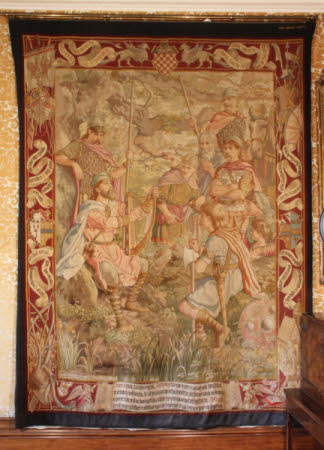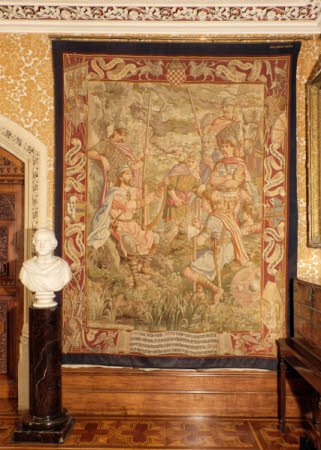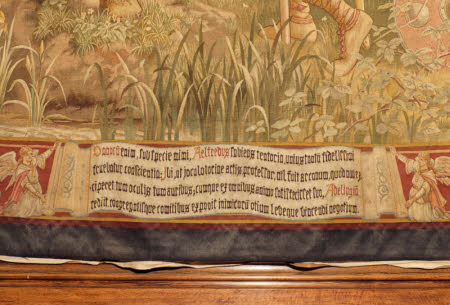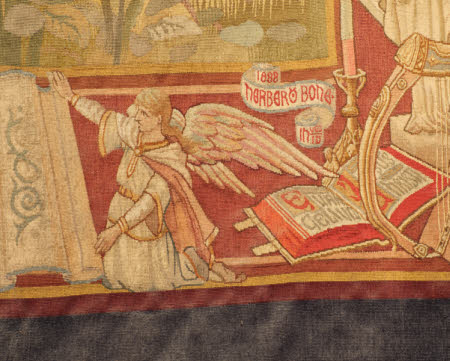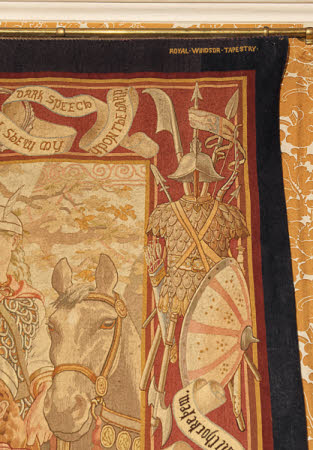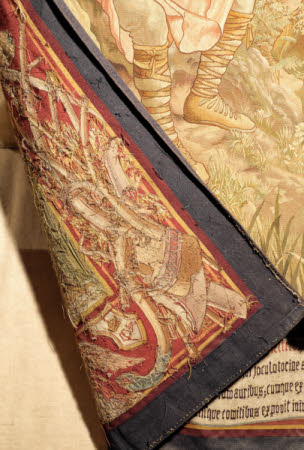King Alfred the Minstrel
Royal Windsor Tapestry Manufactory
Category
Tapestries
Date
circa 1888
Materials
Tapestry, wool, silk and cotton, 6 warps per cm
Measurements
2700 mm (H); 2100 mm (W)
Place of origin
Old Windsor
Order this imageCollection
Tyntesfield, North Somerset
NT 33552.2
Summary
Tapestry, wool and silk, 6 warps per cm, King Alfred the Minstrel from a set of two of the History of King Alfred, Windsor Tapestry Manufactory after a design by Herbert Bone, 1888. The tapestry shows King Alfred in the Danish camp, playing the harp for the King of Denmark and assembled Danes. Alfred sits on the left with his harp on his knee, gazing upwards as he plays and with him mouth slightly open in song. The Danish king stands to the right watching, with his arms folded, a woman and a child to his right and a boy and an old man to his left, all watching intently. A warrior wearing chain mail and a winged helmet stands behind Alfred on the left, another warrior in similar dress approaches on horseback at the top right, and in the right foreground there a youth holding an axe sits with his embossed shield beside him. Strawberry plants and bracken grow around the men’s feet. The scene is a wooded grove with the branches of an oak tree as a backdrop, and a stream running by in the foreground with yellow irises growing to the left and brambles to the right. The tapestry has elaborate borders with pictorial devices and scrolls on a dull red ground. There is Viking ship in the top left corner, a trophy of arms at the top right, a collection of farming implements and a bundle of corn at the bottom left and a chapel, a female saint, a harp and an illuminated book at the lower right. In the centre of each side border there are coats of arms with scrolls bearing inscriptions from Shakespeare and the Bible above and below them. In the upper border there is another coat of arms flanked by two griffins and two more scrolls with inscriptions, and in the lower border two small angels carry a larger scroll with a long Latin inscription. At the left hand side of the lower border there is a small white shield bearing a crown and the letter W, and at the right hand side a scroll with the date 1888 and the name Herbert Bone. A wide dark blue galloon runs around the outside of the borders with the signature of the Windsor Manufactory at the top right.
Full description
The iconography of the two Alfred tapestries is apparently described in details in a pamphlet written by the artist Henry Bone and privately printed in 1888 (Bone 1888). A copy was once in the library at Tyntesfield but is now lost, and it has not been possible to consult the book in writing this catalogue entry. However the inscriptions in the borders of the tapestries describe the events in each scene. The present tapestry depicts the turning point in the ongoing campaign of the Vikings in England. Alfred had been driven from his heartland of Wessex by the Danes and was in hiding. According to William of Malmsbury, whose account in his ‘Chronicle of the Kings of England’ (1125) is quoted in the lower border of the tapestry, after nine years of Alfred’s reign the Danes had made such advances that he was obliged to retreat with his supporters to a small island named Athelney. One night, as they slept on the island, both he and his mother had the same dream, where Saint Cuthbert appeared and said that Alfred would soon be restored to his throne. The Latin inscription in the lower border describes how Alfred was inspired the next day to undertake an audacious mission: “Accompanied only by one of his most faithful adherents, he entered the tent of Aelfredus under the guise of a minstrel; and being admitted, as a professor of the mimic art, to the banqueting room, there was no object of secrecy that he did not minutely attend to both with eyes and ears. When he had satisfied his mind, he returned to Athelney: and assembling his companions, pointed out the indolence of the enemy and the easiness of their defeat.” (translation adapted from Giles 1847, p. 11). The tapestry shows Alfred singing and playing the harp to the assembled Danish camp, who look a little reserved but do not suspect his true identity. The quote on the scrolls in the upper border reads: “I will open my mouth in a parable, I will shew my dark speech upon the harp.” This is taken from the first lines of Psalm 78, however the last phrase, ‘upon the harp’, has been added to refer more directly to the subject of the tapestry. The two ‘King Alfred’ tapestries at Tyntesfield tell the story of King Alfred’s expulsion of the Vikings from his kingdom of Wessex in the year 878. For later generations Alfred came to be a symbol of patriotism and piety, themes prominent in the tapestries. ‘King Alfred the Minstrel’ demonstrates the King’s cunning and determination to defeat the enemy, and ‘The Submission of Gothrum’ the power of his Christianity. The borders elaborate on two overarching themes: the impregnability of the English kingdom, and Alfred’s faith in God. The quote in the scroll at the top of the left hand border, “Back’d with god and with the seas which He hath given for fence impregnable”, comes from Shakespeare’s Henry VI Part 3 (Act 4, Scene 1), and is part of Hastings’s argument to Montagu against forming an alliance with France; it refers to England’s natural defence against invading powers, the sea. In the upper right hand border is another quote from Shakespeare, this time from the Bastard’s speech in the last lines of King John, again made in defiance of the French: “Come the three quarters of the world in armes and we shall shock them” [King John, Act 5, Scene 7]. The second two quotes are Biblical. The scroll in the lower left border reads “While the Earth remaineth Seed time and Harvest shall not fail” [Genesis 8.22], alluding to the constancy of God. The quote in the lower right hand border is taken from Exodus 35.35: “Them hath He filled with wisdom of the Heart to work all manner of work”. In addition each tapestry has a different quote from the Psalms in a scroll in the upper border, and a lengthy Latin inscription in the lower border. The latter are taken from two of the principal chronicles of the Anglo Saxon period, Asser’s Life of King Alfred, and William of Malmsbury’s Chronicle of the Kings of England (1125). These inscriptions both explain the subject of the tapestries and add an air of authenticity to the depictions of King Alfred’s exploits. The pictorial elements of the borders elaborate on elements of the story: the beautifully described Viking ship obviously refers to the Viking invasions; the trophy of arms, taking a Roman form but with Anglo Saxon details, underlines the military valour of Alfred and his army; the collection of farming implements may refer to the period of peace and prosperity that followed the expulsion of the Danes from the Kingdom of Wessex; and the chapel, saint and book in the lower right hand corner refer again to Alfred’s piety. These symbols are joined by a harp, which relates to the subject of ‘King Alfred the Minstrel’, and also a painter’s palette, perhaps introduced as a personal device by the designer Herbert Bone, whose signature appears on a scroll nearby. According to Miller the tapestries were commissioned by Anthony Gibbs (1841-1907) in memory of his parents, William (1790-1875) and Matilda (Miller 2003, p. 126). Their coats of arms appear in the centre of the left and right hand borders to each tapestry. Both were devout Anglicans and supporters of the Oxford Movement, so the pious theme of the tapestries would have been appropriate. The tapestry was made at the Royal Windsor Tapestry Manufactory, whose signature is woven into the upper galloon of each tapestry, and whose monogram, a gold crown over a letter W, appears on a white shield in the lower borders. The manufactory was founded in Old Windsor in 1876 by Henri C Henry, artistic adviser to the furniture company Gillow & Co., and Marcel Brignolas, who came to England with a group of French weavers from the ancient tapestry-producing town of Aubusson. Prince Leopold, Queen Victoria’s youngest son, supported the manufactory and became its president, while the Queen herself made several visits and in 1880 consented to its being termed ‘Royal’. The enterprise began with great success when a series of the ‘Merrie Wives of Windsor’ sent to the 1878 Paris Exhibition won a gold medal. Despite this promising start, and a number of royal commissions, by the time Prince Leopold died in 1884 the manufactory was already in severe financial difficulties. Further investment and commissions were sought and a number of important projects were undertaken in the later 1880s, but in 1890 the manufactory was forced to close. In choosing to commission tapestries from the Royal Windsor Manufactory Anthony Gibbs was probably influenced by his cousin Henry Hucks Gibbs, who was one of the guarantors of the workshop. Following Prince Leopold’s death in 1884 the workshop’s new patron, the Prince of Wales, appealed for new commissions to try and stave of closure. As a result Henry Hucks Gibbs commissioned tapestries for his house at Aldenham, and the commission for the ‘King Alfred’ tapestries, which are woven with the dates 1887 and 1888, was probably made at around the same time (Miller 2003, p. 126; Cullingham 1979, p. 4). Anthony Gibbs had previously bought three narrow tapestry panels after designs made for mosaics by Salviati for the Chapel at Tyntesfield (now kept in storage, nos. 18455, 18456, 18457). Scenes from English literature and history, like the Tyntesfield ‘King Alfred’ tapestries, were a speciality at the Windsor manufactory. The workshop also made a large number of views of Royal palaces, many of them Royal commissions, as well as landscapes and furnishing tapestries in the French style. A tapestry of ‘Europa and the Bull’ originally made for Henry Hucks Gibbs and now in the National Trust’s collection at Kingston Lacy is a rare example of a subject from classical mythology (no. 1258064). The ‘King Alfred’ tapestries were designed by Herbert Bone (1853-1931), whose name appears on a little scroll in the lower border of each tapestry. Bone joined the Windsor manufactory in 1879 and became one of its principal designers. A number of his preparatory drawings for the ‘King Alfred’ tapestries are in the Royal Library at Windsor, part of a collection of several hundred drawings presented to the library by his daughter. The collection also includes preparatory drawings for the ‘Salviati Mosaics’ tapestries of which there are examples at Tyntesfield, and the tapestries woven for Henry Hucks Gibbs at Aldenham, and correspondence about the tapestries between Bone and members of the Gibbs family (Millar 1995, vol. 1, pp. 98-9). According to Cullingham the two ‘King Alfred’ tapestries have been moved twice from their original position at Tyntesfield (Cullingham 1979, pp. 65-6) (Helen Wyld, 2013)
Provenance
Commissioned by Anthony Gibbs (1841-1907) for Tyntesfield and woven in 1888; thence by descent to Richard Gibbs, 2nd Baron Wraxall (1928-2001); Purchased by the National Trust from the estate of Lord Wraxall with the assistance of the NHMF and donations from members and supporters.
Marks and inscriptions
At right hand end of upper galloon: ROYAL WINDSOR TAPESTRY On scrolls in upper border: I will open / my mouth / in a parable, / I will shew my / dark speech / upon the harp [Psalm 78] On scroll at top of left hand border: Back’d with god / and with the / seas which He hath given / for fence impregnable. [Henry VI Part 3, Act 4, Scene 1] On scroll at bottom of left border: While the Earth remaineth / Seed time and Harv / est shall not fail [Genesis 8.22] On scroll at top of right hand border: Come the iii quarters / of the world in armes / and we shall shock them [King John, Act 5, Scene 7] On scroll at bottom of right hand border: Them hath He filled with wis- / dom of the Heart to work / all manner of work [Exodus 35:35] On large scroll in lower border: Danoru[m] enim, sub specie mimi, Aelfredus subiens tentoria unius tantu[m] fidelissimi / fruebatur conscientia: Ibi, ut joculatoriae artis professor, ni[hi]l fuit arcanum quod non ex- / ciperet tum oculis tum auribus; cumque ex omnibus animo satisfecisset suo, Adelingia[m] / rediit, congregatisque comitibus exponit inimicorum otium leveque vincendi negotium. [William of Malmsbury, Chronicle of the Kings of England, Book 5] On small shield at left of lower border: A gold crown over the letter W On small scroll at right of lower border: 1888 / Herbert Bone / Invenit On open book at right of lower border: Evan / gelium / Deus / Christi
Makers and roles
Royal Windsor Tapestry Manufactory , workshop Herbert Alfred Bone (1853/4 - London 1931/2) , designer
References
Miller, 2003 James Miller, Fertile Fortune The Story of Tyntesfield, The National Trust 2003 Hall, 2002: Michael Hall. “Tyntesfield, Somerset.” Country Life 25 Apr. 2002: pp.114-117. Hall, 2002: Michael Hall. “Tyntesfield, Somerset.” Country Life 02 May 2002: pp.96-101. Millar, 1995: Delia Millar, The Victorian Watercolours and Drawings in the Collection of Her Majesty the Queen, 2 vols., London 1995 Cullingham, 1979: Gordon Graham Cullingham, The Royal Windsor Tapestry Manufactory, 1876-1890: an illustrated handlist of tapestries woven at the Old Windsor works, The Royal Borough of Windsor and Maidenhead 1979 Jane, 1908: Lionel Cecil Jane, Asser’s Life of King Alfred, London 1908 Bone, 1881: Herbert Bone, The Windsor Tapestries at Aldenham House, Herts., privately printed, London 1881 Bone, 1888: Herbert Bone, The Windsor Tapestries at Tyntesfield, privately printed, London 1888 Giles, 1847: J A Giles, William of Malmesbury’s Chronicle of the Kings of England. From the Earliest Period to the Reign of King Stephen, London 1847
